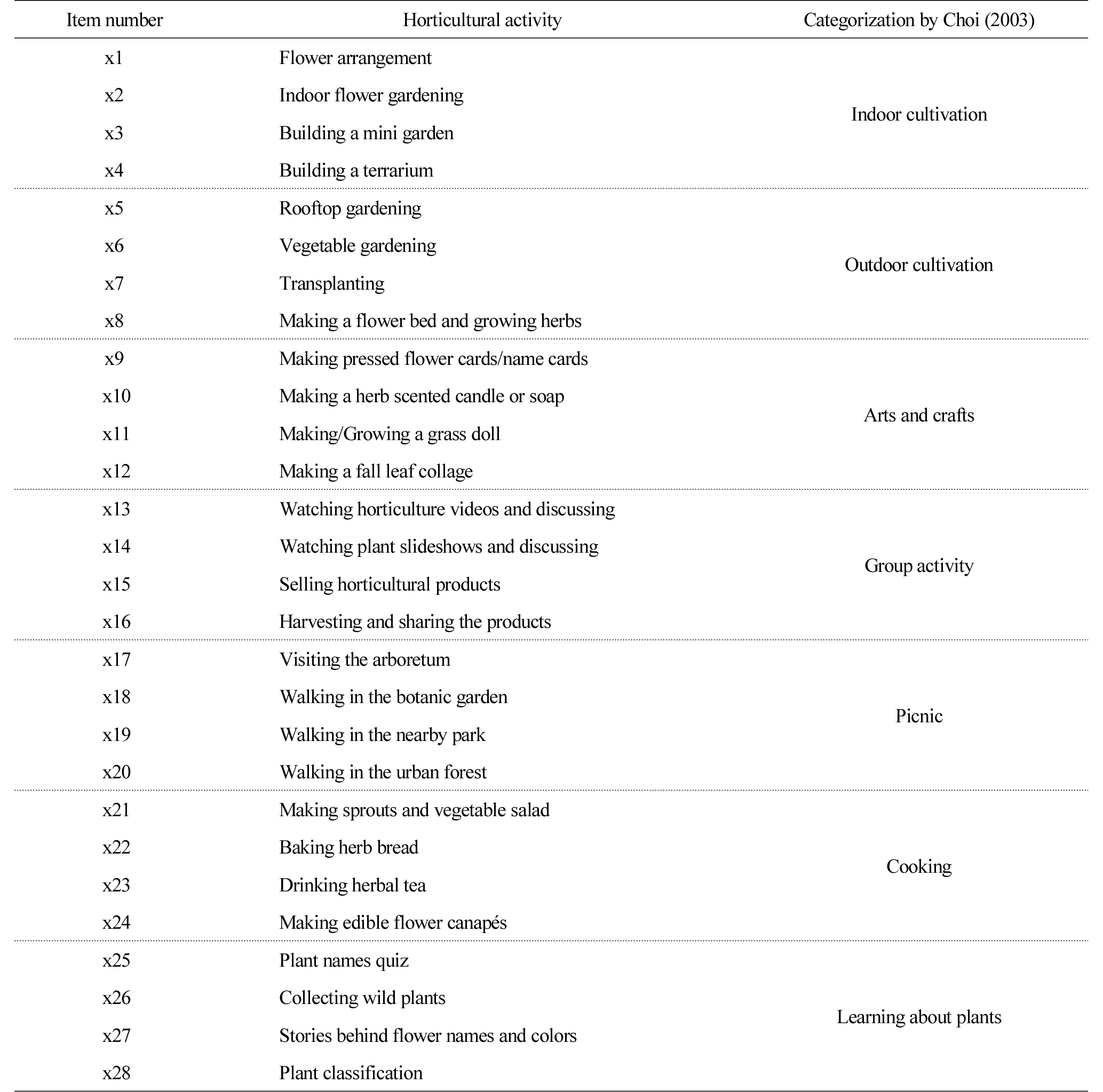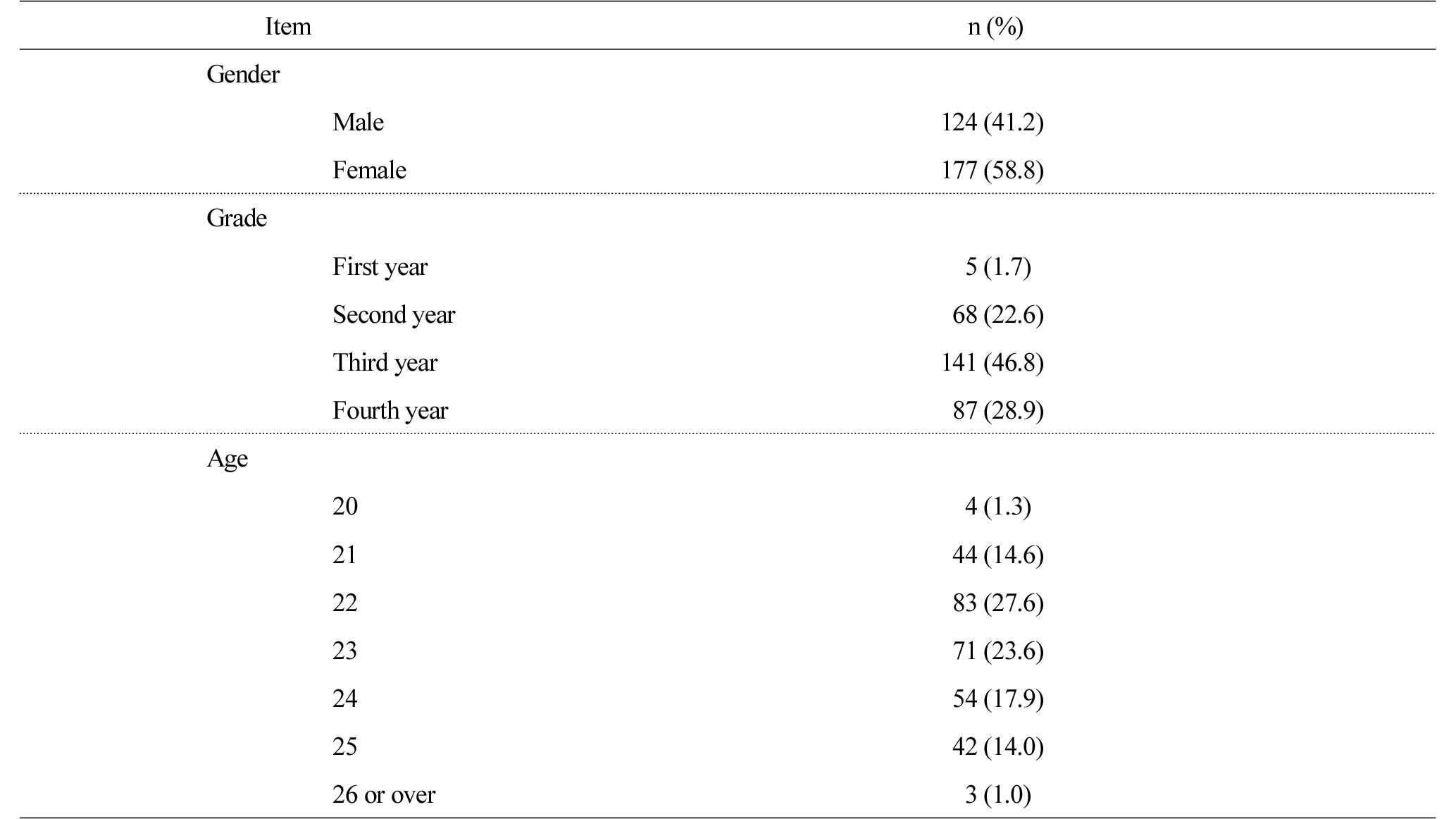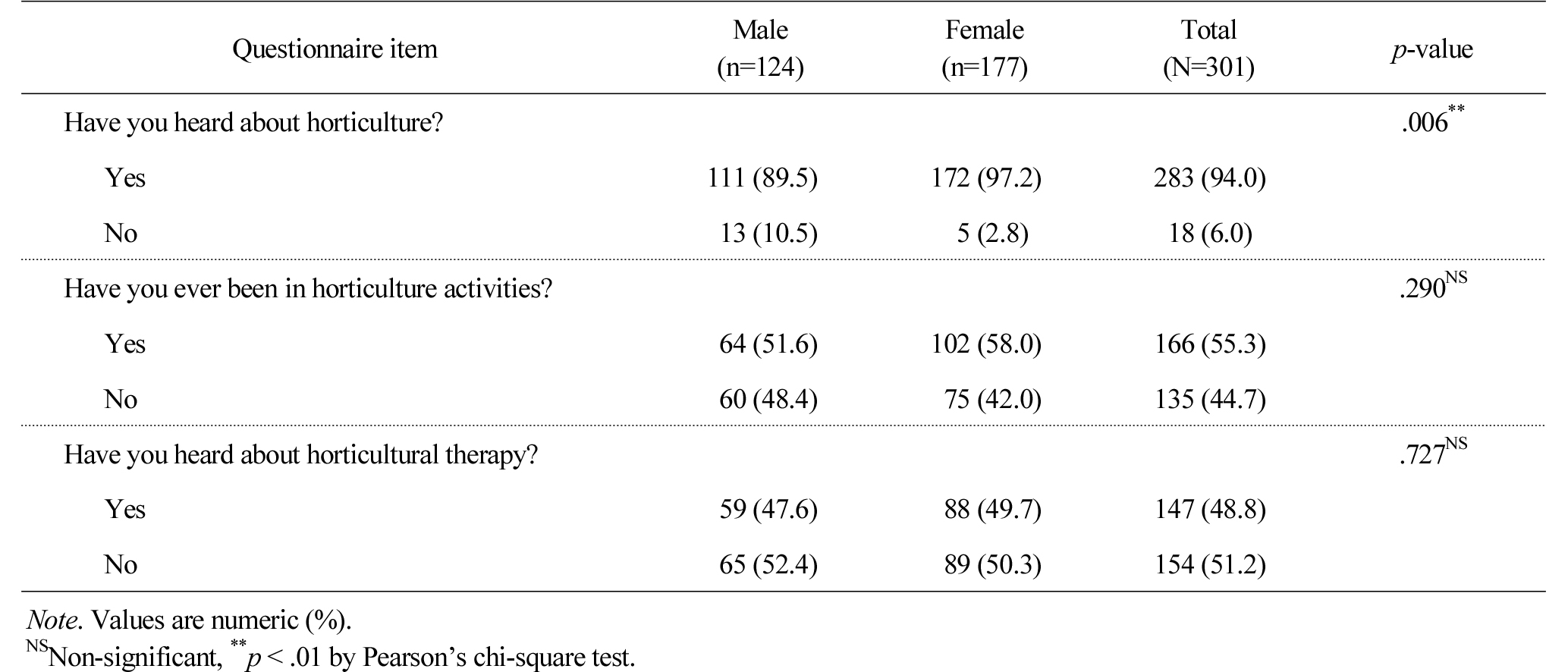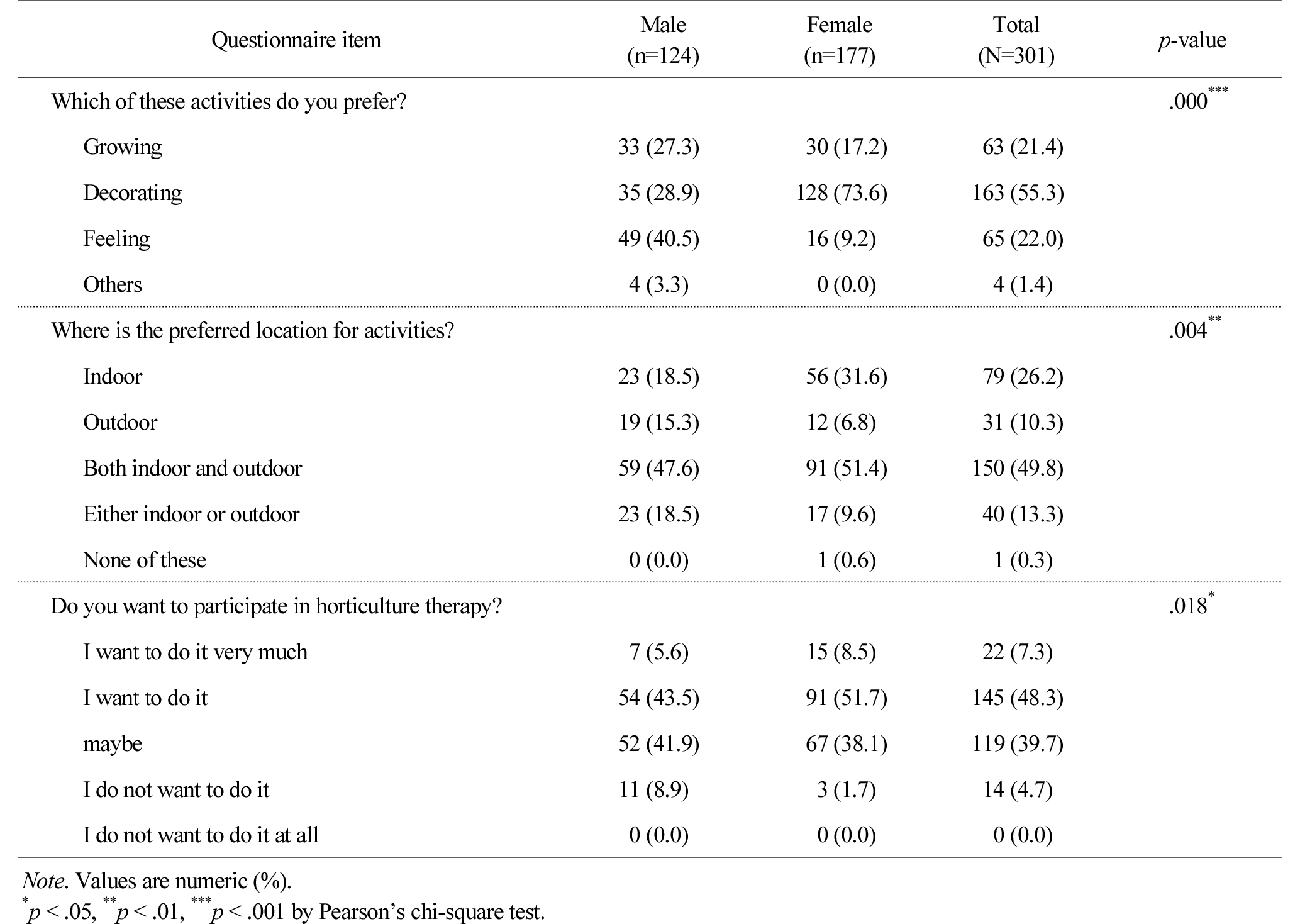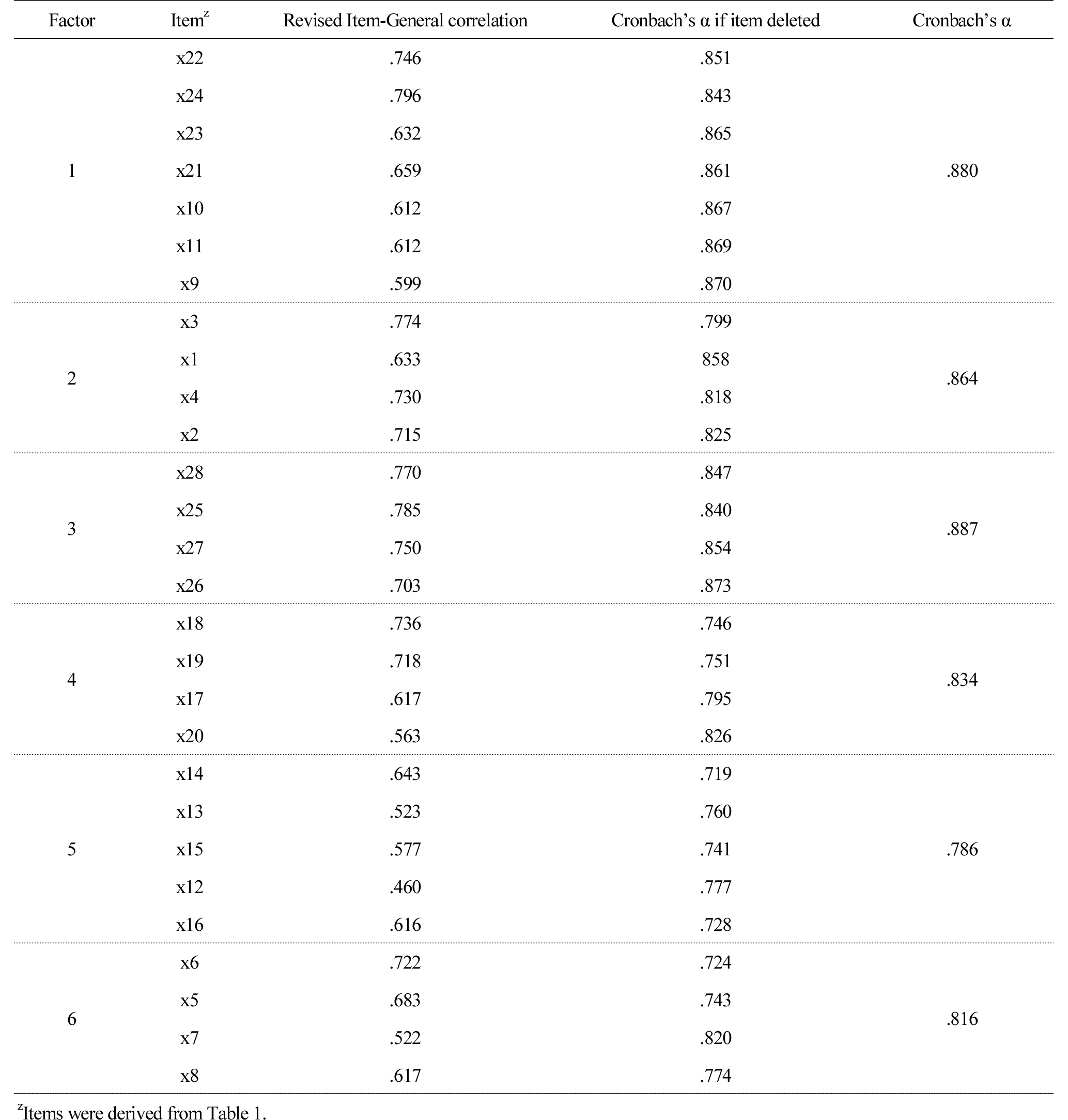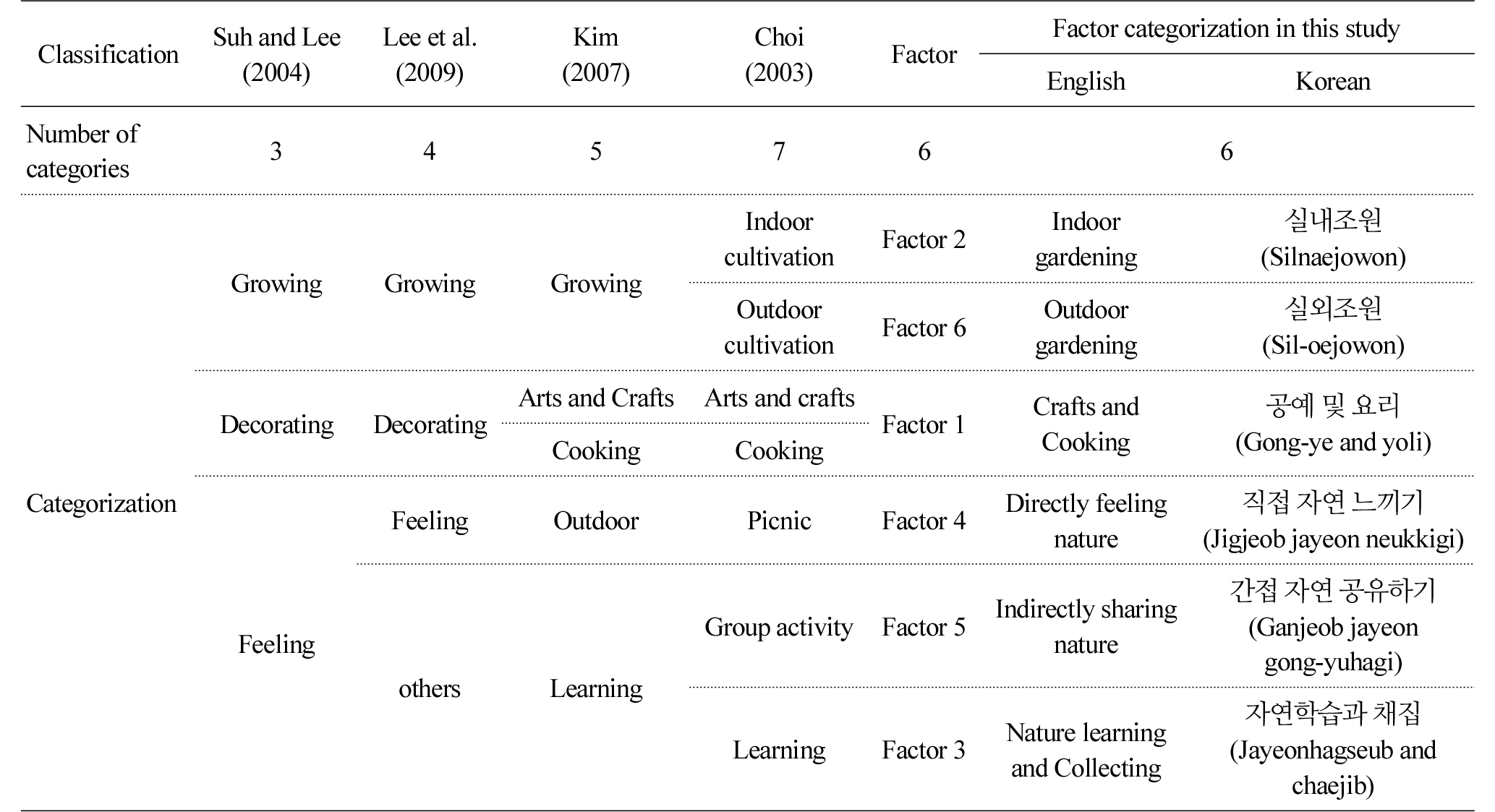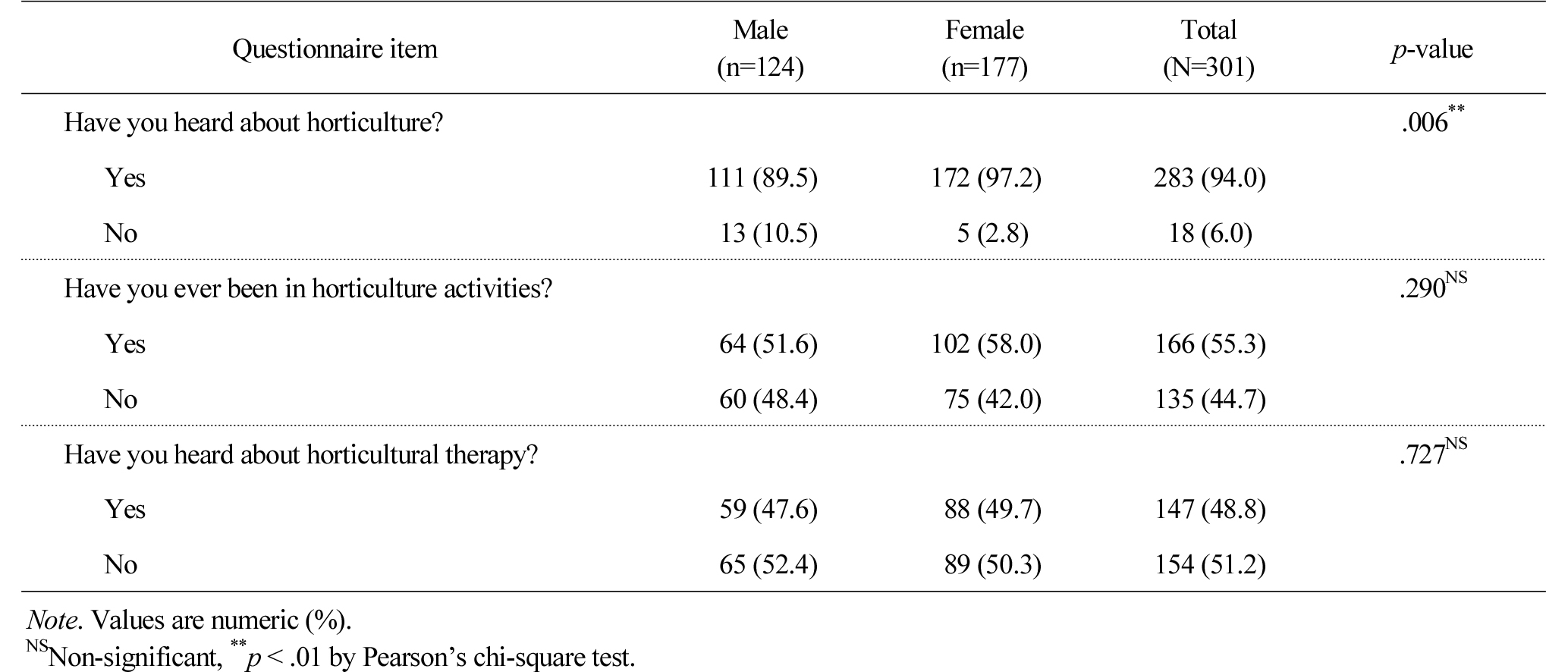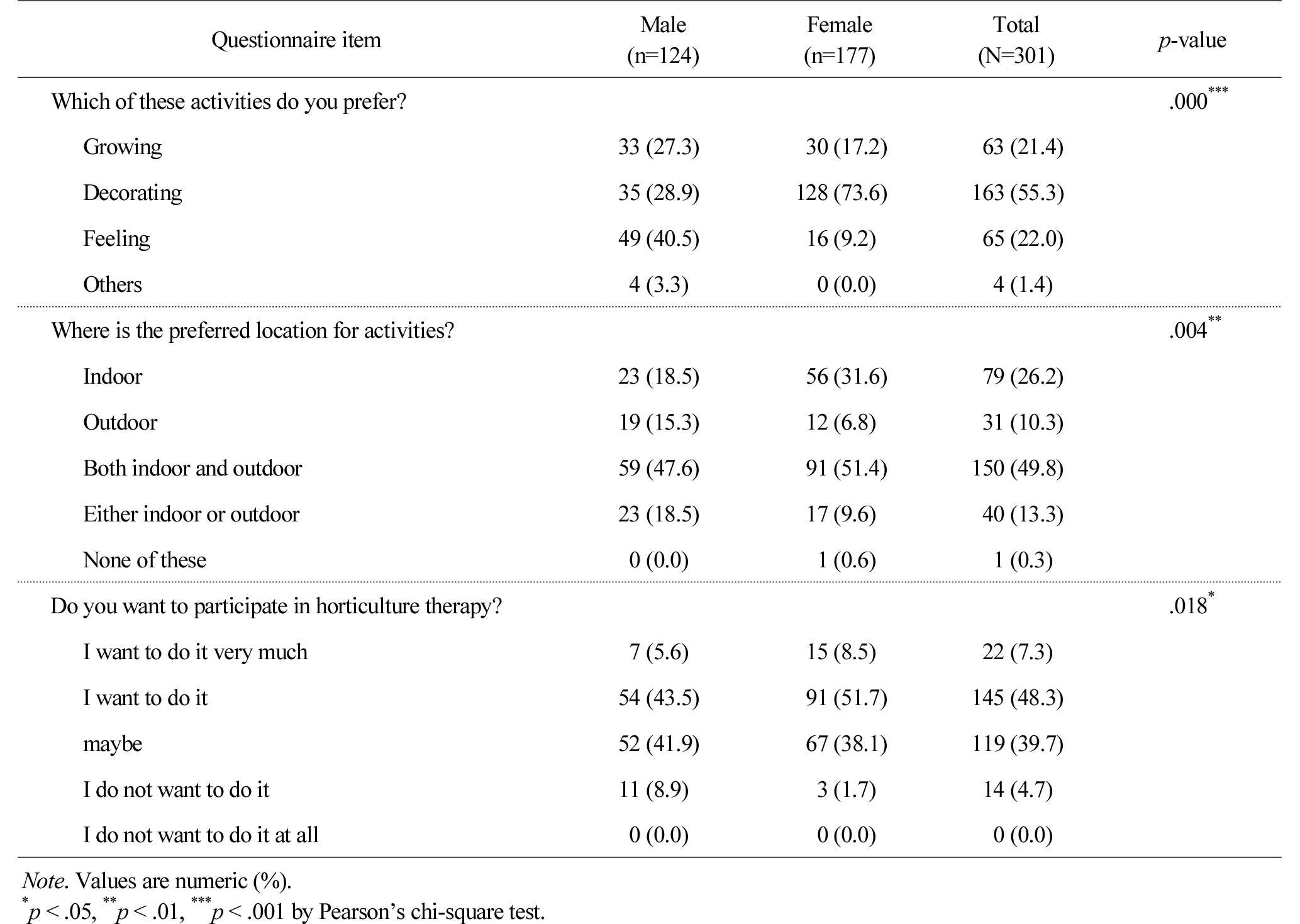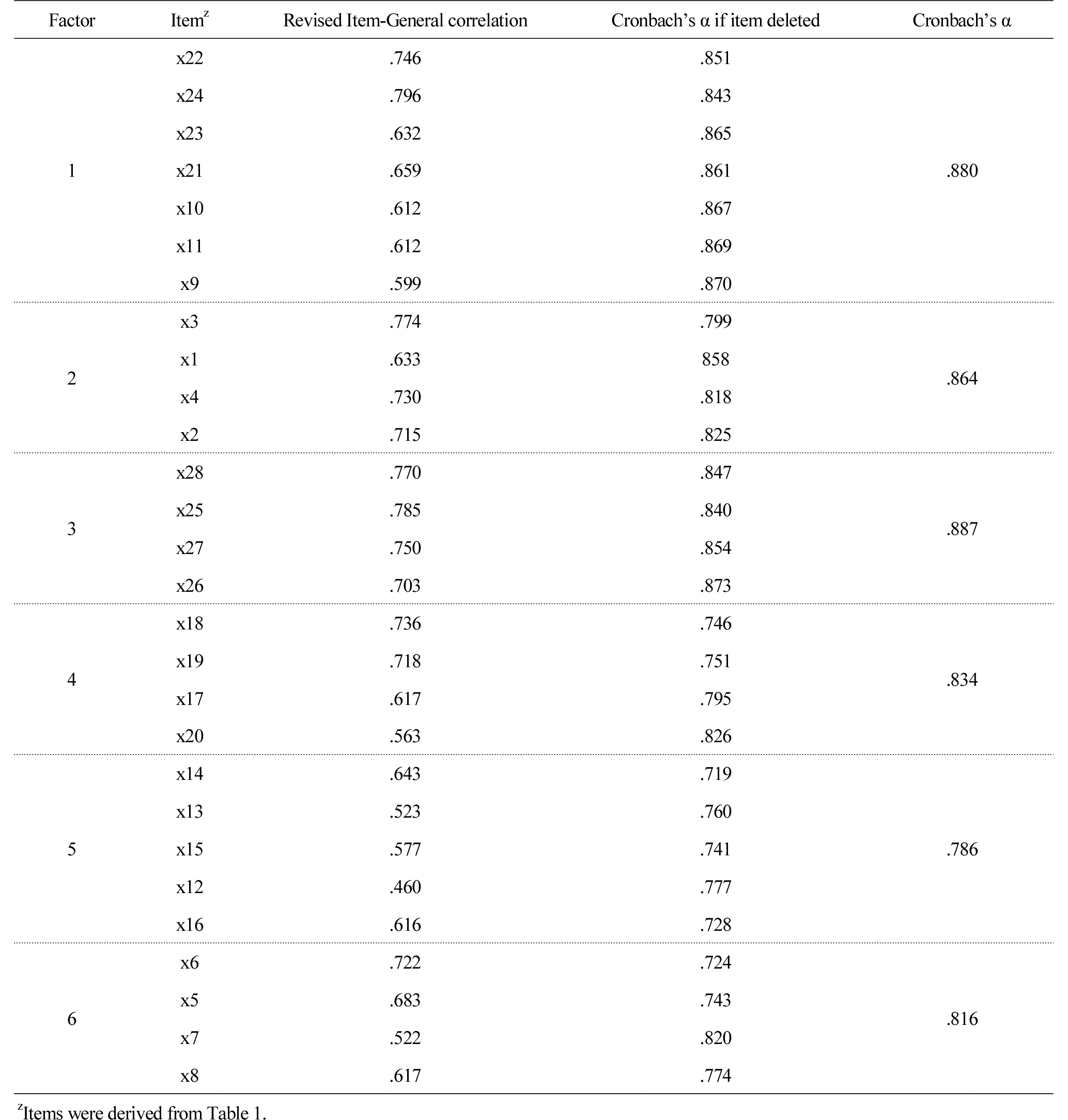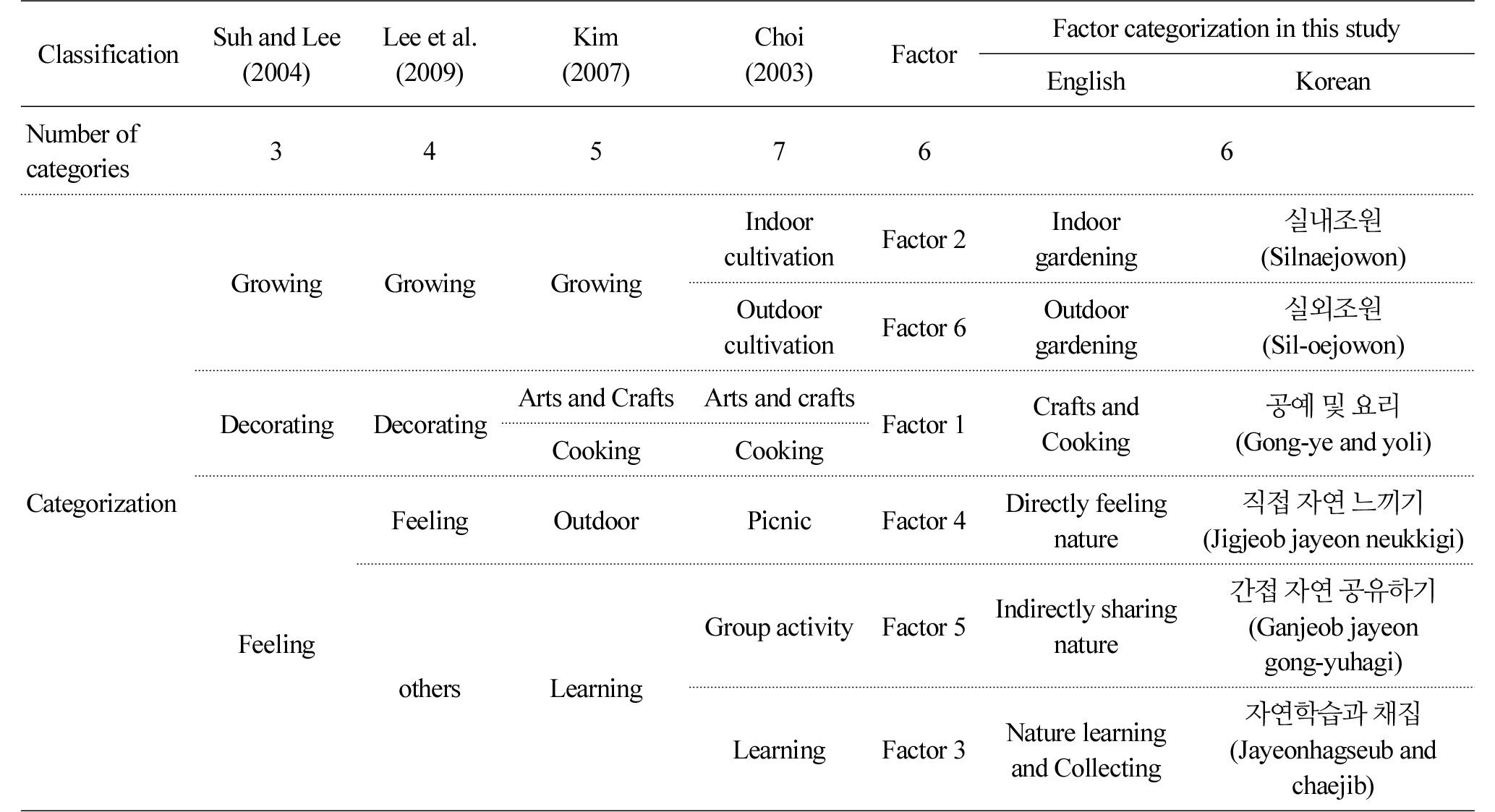Classification of Horticultural Therapy Activity based on Activity Preference of University Students
Article information
Abstract
Horticultural therapy is a horticultural activity using flower and plants as mediators to achieve the therapeutic treatment benefits, and consists of both passive activities and active activities as essential elements. Therefore, this study was conducted to classify the types of activity used for horticultural therapy by surveying 301 university students from March 7 to August 28, 2017 about their knowledge and preference for horticultural therapy activities. As a result of the questionnaire, 94.0% of student participants answered that they have heard about horticulture. But only 48.8% of participants had knowledge of horticultural therapy and there is still a lot of insufficiency in recognition of horticultural therapy. However, after taught what the horticultural therapy is, 55.6% of participants showed positive willingness to participate in horticulture therapy activities. Next, comparison analysis was made by investigating preliminary research papers and factor analysis was performed by examining the preference of the participants for 28 types of selected horticultural therapy activities. Finally, after analyzing characteristics of factors, this study proposes six categories of activities such as “Indoor gardening”, “Outdoor gardening”, “Crafts and Cooking”, “Directly feeling nature”, “Indirectly sharing nature”, and “Nature learning and collecting” to be used as major factors in horticulture therapy. In the limitation of this research, these preferences may differ depending on the age and occupation of the subjects, so in the future study, additional research will be necessary.
Introduction
Horticultural activities, which began to be applied for emotional stability of subjects through stability from nature, are now becoming specialized therapeutic activities that pursue recovery, rehabilitation, promotion of health and preventive purposes (Son et al., 2006; Son et al., 2016). Therapeutic activities through horticulture are included in various categories of complementary and alternative medicine, as well as various categories of the standard set by the National Center for Complementary and Integrative Health under the US National Institutes of Health that is used widely as a classification of complementary and alternative medicine (Kim, 2017).
Horticultural activities in horticultural therapy include indirect and passive activities and direct and active activities with plants as a medium to achieve therapeutic purposes of horticultural therapy, and are defined as essential elements for horticultural therapy (Son et al., 2006; Son et al., 2016). As such, horticultural activities are a tool for horticultural therapy, and thus it is necessary to determine the characteristics of subjects in the assessment stage that is the first stage of horticultural therapy, and to make a suitable plan for horticultural activities based on the above (Suh and Lee, 2004).
Horticultural activities used as a tool for horticultural therapy are categorized with various standards by many scholars. Choi (2003) classified horticultural activities into growing plants indoors and growing plants in an outdoor garden, and additionally subdivided them into arts and crafts, group activities, picnic, cooking and learning about plants, which is the most subdivided classification. Kim (2007) analyzed studies on horticultural therapy for elders and classified horticultural activities into 5 items, such as cultivation, craft, cooking, outdoor and learning activities, and then subdivided the details of each activity. Lee et al. (2009) classified horticultural activities into growing, decorating, feeling and other activities based on the purpose of activity to minimize the redundancy issue of the aforementioned classification,
The therapeutic intervention effect of horticultural therapy only appears when it is accompanied by active interaction through horticultural activities between the subject and therapist, instead of when the condition of the subject changes due to the one-sided therapeutic activity of the therapist (Son et al., 2006; Son et al., 2016). Therefore, for the subjects’ active participation, preference of subjects for horticultural therapy activities will be a crucial factor that affects the results of horticultural therapy programs.
As a study on preference for horticultural activities and garden plants in horticultural therapy, Jeong (2012) studied the plants, flowers and fragrances preferred by university students according to their Myers-Briggs Type Indicator (MBTI) personality types, and the result showed that there was a difference in preferences for plant shape, type or fragrance depending on the personality type. Furthermore, Hong (2016) studied how the different perception on horticultural experiences and preferences of office workers affected stress management response and anger control through horticultural therapy, and the result showed that people with horticultural experience or preference for horticulture tended to have positive influence on the effect of horticultural therapy.
This study was conducted to examine which activities of horticultural therapy are preferred by university students, and how these activities are categorized in terms of preference type. By naming each type by factor based on the preferences, the results will be used as the basic data for application of horticultural therapy in the future.
Research Method
Subjects and method
Subjects
A survey was requested on students in their twenties attending Gyeongsang National University and Gyeongnam National University of Science and Technology located in Jinju, Gyeongsangnam-do, and total 310 students participated in the survey. Statistical analysis was conducted on ultimately 301 participants excluding those who did not respond to all items of the questionnaire. The survey was conducted from March 7 to August 28, 2017 without incentives for participation.
Questionnaire and survey items
(1) Survey on the general characteristics of subjects and perception on horticulture and horticultural therapy
Gender and age were investigated for the general characteristics of subjects. Moreover, the perception on horticultural activities was surveyed based on the perception survey on horticulture by Jeong (2012) using the classification into four types – ‘growing’, ‘decorating’, ‘feeling’ and ‘others’ – presented by Lee et al. (2009). There were total 9 survey items, which included whether the subjects have heard of ‘horticulture’ and ‘horticultural therapy’ and how much they know, as well as their interest and activeness for participation in horticultural activities, and activities they want to try.
(2) Survey on preference for horticultural therapy activities
Total 28 horticultural activities were selected among those used in previous studies on horticultural therapy activities a (Choi, 2003; Son et al., 2006; Oh et al., 2006; Kim, 2007; Lee et al., 2009, Lee et al., 2015), and the preference for each activity was examined (Table 1). The selection standard was based on the 7 types of horticultural activities categorized by Choi (2003) and Oh et al. (2006): indoor cultivation, outdoor cultivation, arts and crafts, group activity, picnic, cooking, and learning about plants. For detailed activities, 4 types were randomly selected for each category as presented in these studies. Preference for each horticultural activity is surveyed using a Likert 5-point scale, with 1 point ‘very unlikely want to do’, 2 points ‘not likely want to do’, 3 points ‘neutral’, 4 points ‘likely want to do’, and 5 points ‘very likely want to do’. The activities were described to the subjects when conducting the survey, and invited the subjects to rate their preference by imagining how much they want to do the relevant activity if they are to participate in horticultural therapy activities.
Analysis method
Statistical analysis was conducted using IBM SPSS statistics 23 after coding the collected questionnaire with Excel. Frequency analysis was conducted on gender and age, as well as on perception and preference of horticulture and horticultural therapy, and Pearson’s chi-squared test was conducted to determine gender differences. Validity was tested on preference measurement variables for each horticultural activity to extract certain factors of horticultural therapy activities, and factor analysis was conducted to classify the factors of the activities. Factors were extracted through varimax rotation among orthogonal rotation methods using the principal component analysis. Then the factors were classified by extracting only those with the eigenvalue of 1 or higher. Reliability analysis was conducted to verify the internal consistency of items by factor, thereby calculating Cronbach’s alpha.
Results and discussions
Demographic characteristics
Table 2 shows the gender, grade and age of the subjects. There were total 301 subjects, and 124 (41.2%) were male students and 177 (58.8%) were female students. By grade, 141 (46.8%) of them were in the third year, followed by 87 (28.9%) in the fourth year, 68 (22.6%) in the second year, and 5 (1.7%) in the first year. By age, 83 (27.6%) were aged 22, followed by 71 (23.6%) aged 23, 54 (17.9%) aged 24, 44 (14.6%) and 42 (14.0%) aged 21 and 25 respectively, and 4 (1.3%) and 3 (1.0%) aged 20 and 26 or over respectively.
Perception and preference in horticulture and horticultural therapy
Perception of university students on horticulture and horticultural therapy
Table 3 shows the basic perception of university students on horticulture and horticultural therapy. Regarding whether they have heard of horticulture, at least 94.0% of the subjects responded that they have, and more female students heard about horticulture than male students. Regarding whether they have experienced activities related to horticulture, at least half of the subjects (55.3%) said they have experience. There was no statistically significant difference according to gender, but slightly more female students (58.0%) had experience in horticulture-related activities than male students (51.6%). This is similar to the findings of Hong (2016) reporting that women show a more positive response toward horticultural activities and prefer them more than men. Next, regarding whether they have heard of ‘horticultural therapy’ more students responded ‘no’ (51.2%) than ‘yes’ (48.8%). This is similar to the result of Jeong (2012) examining the perception of university students on horticultural therapy. While the level of experience in horticulture-related activities increased compared to the study by Jeong (2012), it seems that ‘horticultural therapy’ still remains slightly unfamiliar to students.
Preference for horticultural therapy activities
Table 4 shows the preference of the subjects for horticultural therapy activities. Regarding activities they most want to try, the preference was surveyed on the categories of horticultural therapy activities in the biggest classification presented by Lee et al. (2009) such as growing, decorating, feeling and others. The result showed that 55.3% of the respondents most preferred decorating, and feeling (22.0%) and growing (21.4%) showed similar preferences. There was also a gender difference. Male students showed highest preference for feeling (40.5%), followed by decorating (28.9%) and growing (27.3%) at a similar level. However, 73.6% of female students preferred decorating, followed by feeling (22.0%) and growing (21.4%) at a similar level. The preference of female students was similar to the findings of Jeong (2012), and the result of this study showed that male students had higher preference for feeling than decorating.
Regarding preference for place where horticultural therapy activities are carried out, most of them regardless of gender responded that ‘both indoors and outdoors are good’. However, female students tended to prefer indoor activities more than male students.
In terms of preference about whether they want to participate in a horticultural therapy program if they get the chance, 55.6% showed a positive response, saying that they want to participate. By gender, significantly more female students (60.2%) gave a positive response than male students (49.1%). This result is similar to the findings of Hong (2016) on the perception of office workers on horticulture, according to which women more positively perceive and prefer horticulture or plants than men.
In sum, a more effective program can be made when applying horticultural therapy activities by perceiving that preferred activity and place vary depending on the gender of participants, and by selecting suitable activities based on a preliminary survey on the participants.
Preference factor analysis of horticultural therapy activities and reliability analysis
Preference factor analysis of horticultural therapy activities
As a result of selecting 4 activities for each factor based on the classification of 7 types presented by Choi (2003), surveying the preference of subjects and conducting a factor analysis, the factors were classified into 6 factors as shown in Table 5.
Factor 1 consisted of 7 activities, such as x22 (baking herb bread), x24 (making edible flower canapés), x23 (drinking herbal tea), x21 (making sprouts and vegetable salad), x10 (making a herb scented candle or soap), x11 (making/growing a grass doll), and x9 (making pressed flower cards/name cards). Factor 2 consisted of indoor plant activities, such as x3 (building a mini garden), x1 (flower arrangement), x4 (building a terrarium), and x2 (indoor flower gardening). Factor 3 consisted of learning activities, such as x28 (plant classification), x25 (plant names quiz), x27 (stories behind flower names and colors), and x26 (collecting wild plants). Factor 4 consisted of x18 (walking in the botanic garden), x19 (walking in the nearby park), x17 (visiting the arboretum), and x20 (walking in the urban forest), and Factor 5 consisted of x14 (watching plant slideshows and discussing), x13 (watching horticulture videos and discussing), x15 (selling horticultural products), x12 (making a fall leaf collage), and x16 (harvesting and sharing the products). Finally, Factor 6 consisted of x6 (vegetable gardening), x5 (rooftop gardening), x7 (transplanting), and x8 (making a flower bed and growing herbs). As a result, ‘Factor 1’ was a suitable classification that did not classify decorating and cooking separately but classified cooking as a decorating activity in a concept aside from decoration as mentioned by Lee et al. (2009). However, for other classifications, factors were classified into indoor gardening activity, outdoor gardening activity, group activities, picnic, and learning activities as similar to the classifications of activities presented by Choi (2003) and Oh et al. (2006). However, making a collage presented as a craft activity was classified not as ‘Factor 1’ but as ‘Factor 5’, the factor loading of which did not show a big difference from that of ‘Factor 1’, and thus it is necessary to conduct a preference survey on more subjects.
Internal consistency analysis by preference factor of horticultural therapy activities
Table 6 shows the result of reliability analysis to verify the internal consistency of activities in each factor according to the result of factor classification. In all factors, Cronbach’s α was .786~.887, showing high internal consistency. With regard to internal consistency, Kang (2016) claimed that the figures are reliable of Cronbach’s α is 0.5 or higher, which indicates that factors of each activity are well structuralized. However, for ‘Factor 6’, coefficient (.820) after item ‘x7 (transplanting)’ eliminated, turned out to be higher than the coefficient (.816) of the relevant factor, and thus X7 must be eliminated. In the case of ‘x7 (transplanting)’, unlike other three activities of ‘Factor 6’ such as rooftop gardening, vegetable gardening and making a flower bed and growing herbs, it is not an activity only done outdoors. Thus, there was a gap in understanding of the subjects regarding the action of transplanting whether indoors or outdoors, which led to this result. There must be an activity to make amends for this in follow-up research.
Based on the above, this study surveyed the preference for horticultural therapy activities, and categorized total 6 factors by conducting a factor analysis on the activities (Table 7). We will propose 6 types of classifications of preferred horticultural therapy activities based on the results. First, we propose crafts and cooking (creative activities) by combining Arts/crafts and cooking for ‘Factor 1’, indoor gardening (including flower or plant arrangement in indoor gardening) for ‘Factor 2’, nature learning and collecting for ‘Factor 3’, directly feeling nature (walking in the garden/arboretum/urban forest, appreciating plants, enjoying landscape) for ‘Factor 4’, indirectly sharing nature (watching and discussing horticulture-related video, watching and discussing plant images, selling flowers and horticultural plants, harvesting and sharing) for ‘Factor 5’, and outdoor gardening (making a vegetable garden or creating a garden) for ‘Factor 6’.
Summary of characteristics by preference factors of horticultural therapy activities
Characteristics of each classification of activities in applying the 6 classifications to horticultural therapy are as follows.
① Indoor gardening
‘Indoor gardening’ includes activities similar to ‘indoor cultivation’ mentioned by Choi (2003), characterized by horticultural activities of planting and tending plants directly in an indoor space as well as decorating the interior using plants. Furthermore, there is a difference in the contact time with plants from ‘crafts and cooking’ activities in terms of decoration using plants. Decorating with plants in indoor gardening activities includes the concept of management such as constantly organizing and tending plants. Typical activities include arranging flowers, making a terrarium, and tending an indoor garden.
② Outdoor gardening
‘Outdoor gardening’ activities are directly cultivating and managing plants outdoors in terms of space, similar to ‘outdoor cultivation’ by Choi (2003). However, activities such as ‘sowing’ and ‘replanting’ mentioned by Choi (2003) and Oh et al. (2006) are included in the process of tending a garden or a vegetable garden, but they are not something that can be done only outdoors, and thus must be classified by the place where the activity takes place. Typical activities of ‘outdoor gardening’ include activities making a garden or a vegetable garden, such as tending a vegetable garden, creating an herb garden, and making a rooftop vegetable garden.
③ Crafts and cooking
‘Crafts and cooking’ is activities creating a secondary product by using and processing horticultural products, and through this process the subjects can satisfy their desire to create. It is most similar to the category of ‘decorating’ by Lee et al. (2009), and subjects can instantly feel a sense of achievement by producing an outcome as a one-time activity and there is also not much environmental restraint, and thus most common among horticultural therapy activities today. However, attention must be paid to the fact that this is a results-oriented activity that may proceed to a direction different from obtaining therapeutic effect by taking care of and encountering living plants, which is the basic purpose of horticultural therapy (Lee et al., 2009). Typical activities include making herb bread, making a herb soap, and making pressed flower cards.
④ Directly feeling nature
‘Directly feeling nature’ is the category of ‘picnic’ by Choi (2003), ‘outdoor’ activities by Kim (2007) or ‘feeling’ by Lee et al. (2009), characterized by activities of directly feeling and experiencing the natural environment by being directly exposed to and appreciating nature. Of course, according to Relf (2005), the main therapeutic factor of horticultural therapy is that it is based on taking care of living plants, but considering the diverse positive effects of exposure to natural environment on human beings such as mental stress, fatigue and concentration increase, for which many studies are conducted starting with Hartig et al. (1991), Ulrich (1995), or Kaplan (1995), activities of seeing and feeling nature shall be included in horticultural therapy and not be overlooked. Typical activities include walking in a garden, an arboretum, or an urban forest, appreciating plants, and enjoying the landscape.
⑤ Indirectly sharing nature
‘Indirectly sharing nature’ includes activities of feeling and sharing nature through indirect contact via audiovisual media instead of direct contact, or activities of selling or sharing products obtained from horticultural activities to others. Choi (2003) classified the activities of ‘indirectly sharing nature’ in her study as ‘group’ activities. However, ‘group’ has the meaning of doing something together with many others like a club or an organization (Group, n.d.) and most horticultural therapy activities are carried out in groups, and thus the meaning of ‘group’ activities seamed inappropriate. Accordingly, this study named the relevant category ‘indirectly sharing nature’ so that the common characteristics of activities classified as the same category can be put together into the same category. ‘Indirectly sharing nature’ includes activities that are difficult to expect therapeutic intervention effect through the process of directly taking care of horticultural plants, but they are worth being used as horticultural therapy activities for the therapeutic effect of contact with nature using audiovisual media (Jiang et al., 2014) and the positive effect of building human relations with others (Loue et al., 2014). Typical activities include watching plant slideshows, watching horticulture-related videos, and selling horticultural products.
⑥ Nature learning and collecting
‘Nature learning and collecting’ is characterized by activities learning about nature, such as collecting and classifying plants or learning plant names. ‘Nature learning and collecting’ activities are in a similar category as ‘learning about plants’ category by Choi (2003) and the ‘learning’ category by Kim (2007), including activities such as obtaining knowledge about plants or nature from horticultural therapists, observing plants and finding out about plants. Typical activities include classifying plants, naming plants, talking about stories behind flower names and colors, and collecting wild plants.
Conclusion
With such diverse classifications of horticultural therapy activities today, this study aimed to survey the perception and preference for horticultural therapy activities, classify them through factor analysis and propose a new classification. As a result of examining the perception of subjects on horticulture and horticultural therapy, most of them have heard of ‘horticulture’ but only half of them had actual experience of horticulture-related activities or have heard of ‘horticultural therapy’.
The preference survey on horticultural therapy activities showed that male students preferred feeling activities while female students preferred decorating activities. Both male and female students showed positive response to preferred place of activity, saying that ‘both indoor activity and outdoor activity are good’, and female students tended to more prefer indoor activities. These results indicate that it is necessary to determine the target group in the planning process of a horticultural therapy program and well consider the type and place of activities depending on the gender ratio. Furthermore, regarding whether they would do a horticultural therapy activity if they have the chance, female students more preferred and wanted to participate in horticultural therapy activities than male students, which is similar to the results of other studies where women preferred horticulture more than men. As a result of analyzing the preference for horticultural therapy activities, the activities were ultimately classified into 6 groups, according to which this study will propose the classification of factors of horticultural therapy activities as ‘crafts and cooking’, ‘indoor gardening’, ‘nature learning and collecting’, ‘directly feeling nature’, ‘indirectly sharing nature’, and ‘outdoor gardening’.
The limitation of this study is that the subjects are university students in their 20s. Since the preference for horticultural therapy activities may vary depending on age group or occupational cluster, future research must verify whether the classification of factors proposed in this study applies to other groups by conducting a preference survey on horticultural therapy activities for other groups as well.
